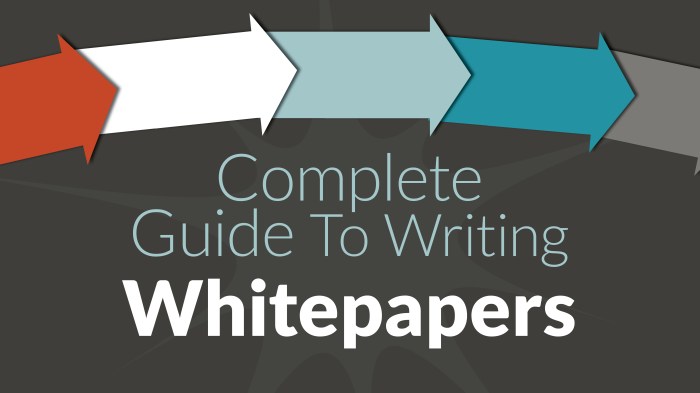Writing Whitepapers dives into the art of creating impactful documents that drive business growth and engagement. From defining whitepapers to exploring key components, this guide is your gateway to mastering this essential marketing tool.
Uncover the secrets behind effective research, writing style, and visual elements that elevate your whitepapers to the next level. Get ready to revolutionize your content strategy with this comprehensive resource.
Introduction to Writing Whitepapers

A whitepaper is a detailed report or guide that addresses a specific issue, problem, or solution in a particular industry. Its purpose is to educate readers and provide in-depth information on a topic, often showcasing a company’s expertise and thought leadership.
Whitepapers play a crucial role in business marketing strategies by establishing credibility, generating leads, and building trust with potential customers. They are commonly used to present research findings, case studies, or technical information in a format that is informative and easy to digest.
Examples of Industries that Commonly Use Whitepapers
- Technology: Companies in the tech industry often use whitepapers to explain complex concepts, introduce new products, or discuss industry trends.
- Finance: Banks and financial institutions use whitepapers to analyze market data, provide investment insights, and offer financial advice to clients.
- Healthcare: Healthcare organizations publish whitepapers to share medical research, clinical trials, and treatment guidelines with healthcare professionals.
- Education: Universities and educational institutions use whitepapers to showcase academic research, propose new teaching methods, and address challenges in the education sector.
Key Components of a Whitepaper

When it comes to crafting a top-notch whitepaper, there are key components that you need to nail down to make it impactful and informative. Let’s break down the essential elements that make up a successful whitepaper.
Title
The title of your whitepaper should be attention-grabbing and clearly convey the topic or main point you will be discussing. Make sure it is concise yet descriptive to capture the reader’s interest right from the start.
Abstract
The abstract serves as a summary of your whitepaper, providing a brief overview of what readers can expect to learn by delving into the document. It should highlight the key points and findings without giving away too much detail.
Introduction
The introduction sets the stage for your whitepaper by introducing the topic, outlining the purpose of the document, and providing an overview of what will be covered. It should hook the reader and entice them to keep reading.
Body
The body of the whitepaper is where you delve deep into the topic, present your research, findings, and analysis. Make sure to organize your content logically, use subheadings to break up different sections, and provide evidence to support your arguments.
Conclusion
The conclusion wraps up your whitepaper by summarizing the main points discussed, reiterating the key takeaways, and possibly offering recommendations or next steps for the reader to consider. It should leave a lasting impression on the reader.
Organization Tips
To effectively organize your whitepaper, consider creating an Artikel before you start writing to ensure a logical flow of information. Use headings and subheadings to break up different sections, bullet points or numbered lists to highlight key points, and visuals like charts or graphs to enhance understanding.
Research and Data Analysis
Research and data analysis are crucial components of creating a successful whitepaper. By conducting thorough research, you can ensure that your content is well-informed, accurate, and credible. Data analysis helps in providing evidence to support your claims and findings, making your whitepaper more persuasive and impactful.
Methods for Gathering Data
- Primary Research: Conducting surveys, interviews, or experiments to gather firsthand data.
- Secondary Research: Utilizing existing data from sources such as articles, reports, and studies.
- Data Mining: Extracting information from large datasets to identify patterns and trends.
Best Practices for Analyzing Data, Writing Whitepapers
- Ensure Data Quality: Verify the accuracy and reliability of the data before using it in your whitepaper.
- Use Data Visualization: Present data in graphs, charts, or tables to make it easier for readers to understand.
- Compare and Contrast: Analyze different datasets to identify correlations and discrepancies.
Writing Style and Tone
When it comes to writing a whitepaper, the appropriate writing style is formal, informative, and persuasive. It should be structured, organized, and backed by research and data analysis to support the key components discussed.
Maintaining a professional tone throughout the whitepaper is crucial to establish credibility and trust with the readers. It is important to avoid using slang, colloquial language, or overly casual expressions. Instead, the language should be clear, concise, and objective to convey the intended message effectively.
Language and Vocabulary for Whitepaper Writing
In whitepaper writing, it is essential to use technical language and industry-specific terminology to demonstrate expertise and knowledge on the subject matter. Avoid jargon that may confuse the readers and opt for precise and meaningful words to convey complex ideas.
Examples of suitable language and vocabulary for whitepaper writing include terms like “analysis,” “strategic,” “implementation,” “solution,” “innovative,” “efficiency,” “impact,” “trend,” “benchmark,” and “best practices.” These words help to convey authority and expertise while maintaining a professional tone throughout the whitepaper.
Visual Elements in Whitepapers: Writing Whitepapers
Visual elements such as charts, graphs, and images play a crucial role in enhancing the content of whitepapers. They not only make the information more visually appealing but also help in conveying complex data in a more understandable manner. Here, we will explore how to effectively incorporate these visual elements to support the written information and share tips on designing visually engaging whitepapers that captivate readers.
Role of Visuals in Enhancing Content
Visual elements like charts and graphs can simplify complex data and make it more digestible for readers. By presenting information visually, whitepapers can communicate key points more effectively and help readers grasp the main ideas quickly. Images can also break up the text and make the content more engaging, keeping the reader’s attention throughout the document.
Incorporating Visual Elements Effectively
When including visual elements in a whitepaper, it is essential to ensure they align with the written content and enhance the overall message. Charts and graphs should be clearly labeled and referenced in the text to provide context for the data presented. Images should be high-quality and relevant to the topic discussed, adding value to the information provided. By strategically placing visual elements throughout the whitepaper, you can create a seamless flow between the text and visuals, making the content more cohesive and engaging.
Designing Visually Appealing Whitepapers
To design visually appealing whitepapers, consider the overall layout and formatting of the document. Use a consistent color scheme and typography to maintain a professional look and feel. Incorporate white space to improve readability and avoid cluttering the page with too many visual elements. When creating charts and graphs, choose the right type of visualization that best represents the data and use annotations to provide additional context. By paying attention to the design details, you can create whitepapers that not only inform but also captivate and engage readers from start to finish.
